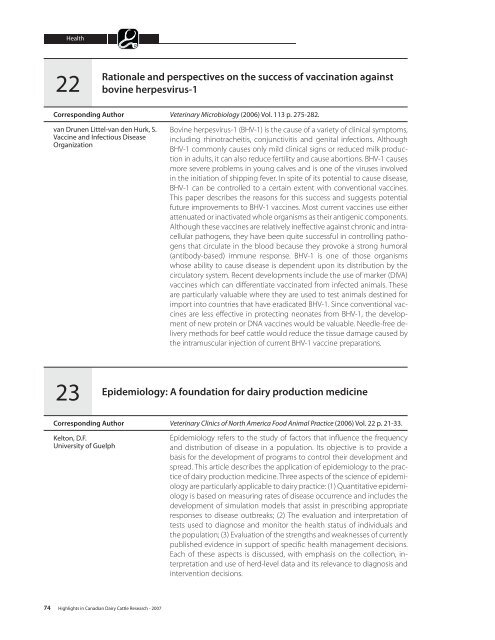A52-75-2007E.pdf - AgroMedia International Inc
A52-75-2007E.pdf - AgroMedia International Inc
A52-75-2007E.pdf - AgroMedia International Inc
Create successful ePaper yourself
Turn your PDF publications into a flip-book with our unique Google optimized e-Paper software.
Health22Rationale and perspectives on the success of vaccination againstbovine herpesvirus-1Corresponding Authorvan Drunen Littel-van den Hurk, S.Vaccine and Infectious DiseaseOrganizationVeterinary Microbiology (2006) Vol. 113 p. 2<strong>75</strong>-282.Bovine herpesvirus-1 (BHV-1) is the cause of a variety of clinical symptoms,including rhinotracheitis, conjunctivitis and genital infections. AlthoughBHV-1 commonly causes only mild clinical signs or reduced milk productionin adults, it can also reduce fertility and cause abortions. BHV-1 causesmore severe problems in young calves and is one of the viruses involvedin the initiation of shipping fever. In spite of its potential to cause disease,BHV-1 can be controlled to a certain extent with conventional vaccines.This paper describes the reasons for this success and suggests potentialfuture improvements to BHV-1 vaccines. Most current vaccines use eitherattenuated or inactivated whole organisms as their antigenic components.Although these vaccines are relatively ineffective against chronic and intracellularpathogens, they have been quite successful in controlling pathogensthat circulate in the blood because they provoke a strong humoral(antibody-based) immune response. BHV-1 is one of those organismswhose ability to cause disease is dependent upon its distribution by thecirculatory system. Recent developments include the use of marker (DIVA)vaccines which can differentiate vaccinated from infected animals. Theseare particularly valuable where they are used to test animals destined forimport into countries that have eradicated BHV-1. Since conventional vaccinesare less effective in protecting neonates from BHV-1, the developmentof new protein or DNA vaccines would be valuable. Needle-free deliverymethods for beef cattle would reduce the tissue damage caused bythe intramuscular injection of current BHV-1 vaccine preparations.23Epidemiology: A foundation for dairy production medicineCorresponding AuthorKelton, D.F.University of GuelphVeterinary Clinics of North America Food Animal Practice (2006) Vol. 22 p. 21-33.Epidemiology refers to the study of factors that influence the frequencyand distribution of disease in a population. Its objective is to provide abasis for the development of programs to control their development andspread. This article describes the application of epidemiology to the practiceof dairy production medicine. Three aspects of the science of epidemiologyare particularly applicable to dairy practice: (1) Quantitative epidemiologyis based on measuring rates of disease occurrence and includes thedevelopment of simulation models that assist in prescribing appropriateresponses to disease outbreaks; (2) The evaluation and interpretation oftests used to diagnose and monitor the health status of individuals andthe population; (3) Evaluation of the strengths and weaknesses of currentlypublished evidence in support of specific health management decisions.Each of these aspects is discussed, with emphasis on the collection, interpretationand use of herd-level data and its relevance to diagnosis andintervention decisions.74 Highlights in Canadian Dairy Cattle Research - 2007





